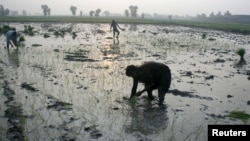For centuries, rice farmers like Sardar Muhammad have been transplanting seedlings in order to grow crops in parched Punjab Province. But amid an erratic monsoon season, learning how to plant the seeds directly in his fields is helping Muhammad make the most of scarce water and ensure a decent harvest.
Growing rice this way -- in which rice seeds are sown straight into the moistened soil and do not need to be submerged -- "requires less labor and less irrigation," he said.
In Punjab, 30 farmers so far have switched to this water-saving technique, covering a total of 118.6 acres.
Traditionally, seedlings are cultivated in nurseries for several weeks before being transferred to flooded fields, requiring about a third more water. In addition, the crop takes 15 to 20 days longer to mature.
An average of 3,000 liters of water are used to produce 1 kilogram of rice in Pakistan, where it is the staple food item. But prolonged water scarcity -- caused by climate change altering weather patterns, monsoon rainfall and reducing groundwater -- has put pressure on farmers to find more efficient methods.
A recent report from the Planning Commission of Pakistan showed that, in 1951, per-capita water availability was 5,650 cubic meters. That figure had plunged to 1,000 cubic meters by 2010 and is projected to fall to 800 cubic meters by 2025, when the population is expected to hit 221 million.
Skipping the transplanting stage may be one way to maintain rice production while also reducing the migration of hard-hit farmers as they search for other work.
Muhammad grows rice on his family's 15 hectares in Sheikhupura district. He said switching to the new planting method had cut the amount of irrigation needed in his rice fields by around 40 percent, a crucial change as groundwater levels drop.
"This is really no small benefit," he said. "This is helping us adapt to water shortages."
Farmers learned the new method via a four-year agricultural innovation program launched in 2013 by partners such as the U.S. Aid for International Development and the International Rice Research Institute.
The project has also introduced heat-tolerant maize and high-yielding wheat varieties, as well as its rice techniques.
Muhammad Ibrahim Mughal, chairman of Agri Forum Pakistan, a farmers' rights organization, said traditional rice cultivation is time-consuming and physically grueling. As river flows decrease and groundwater declines, it has also become less viable, he added.
Farmers are now increasingly willing to try out the new growing methods, said Sardar Karim, another farmer from Punjab Province.
Direct sowing is producing a 25 percent boost in harvests under ideal conditions on the test plots, said Iftikhar Ahmed, chairman of the Pakistan Agricultural Research Council.
With reporting by Saleem Shaikh and Sughra Tunio for Reuters






